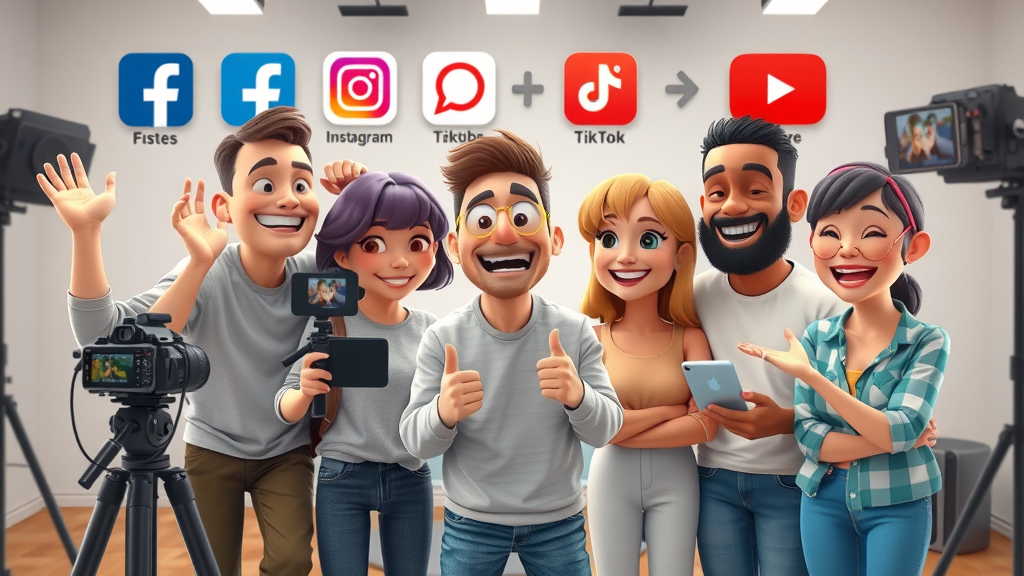Did you know 85% of internet users in the US watch videos online every month ? In today’s fast-paced world, your window to grab their attention on social media is shorter than ever. In this guide, you’ll discover proven strategies, psychology-backed techniques, and practical tips to create engaging video content that stops the scroll and builds loyal followers. Whether you’re a content creator, digital marketer, or brand, mastering these skills will put your videos at the top of feeds—and minds.
Start Strong: Why Engaging Video Content Matters More Than Ever
- A staggering 85% of internet users in the US watch videos online monthly—discover why captivating your audience from the first seconds of your engaging video content is essential to stand out on social media and media platforms.

In the digital age, video content reigns supreme on nearly every social media platform . Platforms like Facebook, Instagram, TikTok, and YouTube are saturated with content, making it crucial to stake your claim within the first few seconds. With attention spans shorter than ever, engaging video content is the only way to ensure your message is not just seen but remembered.
The sheer volume of video content online means that average, uninspired videos are easily overlooked. Viewers demand instant value—whether it's entertainment, information, or inspiration. By starting strong, your videos can surpass the competition, leading to higher engagement metrics such as likes, comments, shares, and watch time. This early engagement signals algorithms to boost your content, further increasing your reach and impact across all media platforms .
The Science Behind Attention: What Makes Engaging Video Content Work Across Social Media
"Engaging video content leverages both psychology and creativity to capture attention within 3 seconds—otherwise, viewers scroll on."
- Key hooks and interactive scenarios that foster instant connection, utilizing visual elements and a clear content strategy.
The science of attention is clear: our brains are wired to respond to novelty, emotion, and strong visual cues. Engaging video content employs creativity and psychological triggers to connect with viewers instantly. By utilizing eye-catching thumbnails, bold intros, and relatable scenarios, creators can interrupt a viewer’s routine scrolling pattern within seconds.
Interactive scenarios—such as asking questions, incorporating polls, or prompting reactions—invite immediate viewer engagement, making the content feel personal. Visual elements like animated graphics, dynamic text, and high-contrast color schemes enhance the sensory experience, holding the viewer’s focus. A well-crafted content strategy ensures these hooks align with your brand message, maximizing their effectiveness across any social media or media platform .
Defining Engaging Video Content for Every Media Platform
- Explore what truly defines engaging video content on social media and various media platforms, focusing on compelling storytelling and the effective use of visual elements.

Engaging video content begins with the seamless merging of storytelling and visual flair. On every media platform , successful videos are crafted to blend emotional arcs, humor, or drama with slick production and clear, captivating visuals. The secret isn’t just high production value, but a genuine understanding of what your target audience craves from their video content .
Platforms like Instagram thrive on bite-sized inspiration, while YouTube allows for deeper dives. TikTok users love bold experimentation and innovative storytelling formats. No matter the destination, the hallmark of engaging video content remains constant: it’s memorable, relatable, and provides a clear takeaway or feeling the audience craves. Consistently pairing visual elements (like graphics, overlays, or animations) with story ensures lasting impact.
How to Recognize Truly Engaging Video Content in Video Marketing
- Look for high retention rates, active engagement, and increased shares as hallmarks of engaging video content.
Not all videos are created equal, and measuring engaging video content goes beyond counting views. High retention rates indicate that viewers watch past the first few seconds—a sign that your hook works. Look for metrics such as average watch time, replays, and click-through rates to evaluate impact. Engaging videos spark conversations, leading to more comments, shares, and even duets or stitches on platforms like TikTok.
| Video Format | Average Retention Rate | Engagement (Likes, Comments, Shares) | Best Platform |
|---|---|---|---|
| Short-Form Reel/Story | 60–80% | High | Instagram, TikTok, Facebook |
| Explainer Video | 50–70% | Medium–High | YouTube, LinkedIn |
| Live Stream | 40–60% | High (real-time) | Facebook, YouTube, Twitch |
| Interview/Podcast Clip | 45–65% | Medium | YouTube, LinkedIn |
If your video marketing reports high numbers in these areas, you know your strategy is working. But real engaging video content also elicits unsolicited audience actions—like direct messages and off-platform chatter—which are the ultimate proof of real people making genuine connections with your content.
Foundational Strategies: Building a Content Strategy for Engaging Video Content
- Establish key goals, define your target audience, and select the most effective video format for your brand’s needs. Your engaging video content must be strategically planned for optimal impact on social media platforms.

A content strategy is the backbone of any successful engaging video content campaign. Start by clarifying your objectives: are you raising brand awareness, generating leads, or driving direct conversions? Next, detail your target audience —including their age range, interests, online habits, and the social media platforms they frequent. This research ensures each piece of video content is tailored for maximum resonance.
Once you have clear goals and an identified audience, select the video format that best fits each platform and campaign. Explainer videos build trust and clarify complex ideas, while live videos promote real-time interaction. Short-form reels and stories offer immediate entertainment and trend potential. Mapping these formats to core brand messages cements consistency, keeping viewers coming back for more across every channel.
Understanding Your Target Audience to Create Content That Resonates
- Research demographics and preferences for each social media platform to create engaging videos that truly resonate with your intended audience.
One of the most important steps in video content creation is truly knowing your target audience . Social listening tools, platform analytics, and trend analyses all help gather demographic data and user preferences—critical for crafting engaging video content that speaks to real people. Are your viewers teenagers on TikTok, professionals on LinkedIn, or families on Facebook? Each group expects different visual elements and storytelling styles.
By carefully reviewing which engaging videos perform best among your audience segments, you can tailor your messaging, pacing, humor, and even production value for maximum impact. Empathy drives successful content: reflect your audience’s values, answer their questions, and solve their pain points with every video.
Aligning Brand Message With Engaging Videos for Consistency on Social Media
Consistency is key for any content strategy . While each video should stand out, all your content must remain unmistakably “you”—regardless of the social media platform . This means developing a recognizable tone, repeating signature visual elements, and anchoring your engaging video content in brand values and purpose.
By aligning every upload with your overall message, viewers subconsciously link positive feelings with your brand. Over time, this builds trust, loyalty, and a distinct competitive advantage, turning casual viewers into brand advocates.
Crafting the Perfect Hook: Capture Attention With Engaging Video Content
- Master the art of grabbing attention using creative hooks, bold claims, and emotional storytelling in your engaging video content.

Creating an irresistible hook at the start of your engaging video content can be the difference between a viral hit and a missed opportunity. Use powerful visuals, fascinating facts, or open with a bold question to intrigue audiences. Whether it’s an unexpected twist, an emotional confession, or a visually stunning intro sequence, the goal is always to keep viewers saying, “What happens next?”.
Emotional storytelling further pulls the audience into your content strategy. When viewers recognize their own stories, dreams, or challenges reflected on screen, they’re much more likely to stick around, comment, and share your marketing video across social media channels.
Best Practices for Opening Scenes in Video Content
- Use fast-paced edits, dynamic visual elements, and a clear value proposition.
The opening seconds of any video content are critical. Start with fast-paced cuts to create energy and urgency. Immediately display your product, solution, or story, backed by animated titles or high-contrast color schemes. Make your value clear—whether you’re solving a problem, providing an answer, or simply entertaining. Always address the audience directly or create suspense to make them feel involved.
Remember: viewers will decide in the first 3–5 seconds whether your video is worth watching. Applying these best practices assures that your engaging video content rises above the noise on any media platform .
Visual Elements that Hook Viewers Instantly
- Incorporate visual storytelling, graphics, text overlays, and strong color palettes to make your video content stand out on social media platforms.
Combining the right visual elements is crucial for standing out. Start with eye-catching thumbnails, bold fonts, and a vibrant but consistent color palette that mirrors your brand identity. Animated graphics, charts, or simple text overlays can clarify complex messages—especially in explainer videos or step-by-step tutorials.
Don’t forget kinetic transitions, sound effects, or on-screen widgets (such as likes, hearts, comments) for instant feedback. Strategic use of close-ups on real people’s faces or quick “behind the scenes” shots creates authenticity and builds connection across all social media platforms .
Watch above: Top 5 video hooks that drive instant engagement!
Choosing the Right Video Format for Engaging Video Content
- Compare explainer video, live video, short-form content, and interviews—discover which video format drives the most engagement on key media platforms.

Not all video formats perform equally well everywhere. Matching your content style to the social media platform and audience is foundational for success. Explainer videos work best for B2B and educational topics, while short-form reels and TikTok videos excel at entertainment and trend-driven discovery. Live videos encourage spontaneous conversation and Q&A moments.
| Video Format | Pros | Cons | Ideal Use |
|---|---|---|---|
| Explainer Video | Clarifies complex topics, builds authority | Longer production timeline | Product demos, B2B, education |
| Short-Form Reels | Quick to produce, highly shareable | Limited depth/nuance | Entertainment, brand awareness |
| Live Video | Authentic, boosts real-time engagement | Requires more planning, can be unpredictable | Launches, interactive Q&As |
| Interview/Podcast | Builds credibility, diverse viewpoints | Longer format, may lose attention | Thought leadership, deep dives |
Selecting the right type of video for your brand and goal maximizes viewer attention and interaction. Above all, align your video content format with both the platform norms and your brand’s content strategy.
Case Study: Successful Explainer Videos as Engaging Video Content
- Analyze how explainer videos break down complex information and drive high engagement.
Consider an animated explainer video that introduces a new software product or service to a broad audience. By visually breaking down key benefits and demonstrating real-world applications, these explainer videos simplify complexity and make learning both fun and memorable. Brands like Dropbox and HubSpot have harnessed this power to rocket user signups and customer satisfaction.
What makes these explainer videos so effective is their blend of story-driven visuals, concise narration, and a compelling call to action. They address pain points, answer FAQs, and leave viewers equipped to take the next step—whether that’s signing up, purchasing, or sharing with others. This proves that well-crafted engaging video content isn't just watched—it's acted upon.
Creating High-Impact Engaging Video Content for Social Media Platforms
- Actionable steps for developing engaging video content that performs on Facebook, Instagram, TikTok, and YouTube.

For video content to truly go viral, you need to tailor each part—format, theme, and visuals—to the specific quirks of each social media platform . Start by mapping out a content calendar, ensuring you post consistently at times your audience is most active. Leverage cross-promotion to boost reach, but always customize message and aspect ratio to each platform.
Use the “three Es” approach for engaging video content: Educate (share tips, answer questions), Entertain (trend-based humor, challenges), and Empower (motivate action or change). For instance, YouTube videos benefit from searchable titles and SEO, while Instagram Stories rely on immediacy and interaction. TikTok rewards risk-taking and creative experimentation. Always analyze results and iterate based on audience response.
Tailoring Engaging Video Content to Different Social Media Platforms
- Adapt aspect ratios, video lengths, and messaging for each platform’s audience and algorithm.
Each media platform has unique best practices. Instagram Reels and TikTok favor vertical formats and concise, energetic stories under a minute. YouTube, by contrast, can sustain longer-form educational videos, allowing for more detailed storytelling or tutorials. LinkedIn videos should stay professional and focus on value-driven content.
Always consider the preferred interaction styles—polls and emoji sliders on Instagram, duets and trending sounds on TikTok, or in-depth polls and discussions on YouTube Community. Adapting format, style, and language for each social media platform ensures no opportunity is wasted for viewer connection.
Optimizing Visual Elements for Mobile and Web Formats
With most video content now consumed on mobile, mobile optimization is essential for engagement. Design every piece of engaging video content with readable captions, bold graphics, and clear calls to action that are easily tappable.
Ensure your visuals remain crisp and uncluttered even on smaller screens, and always test video sound with and without audio (as many users watch muted). For web and desktop, take advantage of widescreen space but keep core messages and CTAs near the video’s center, where attention is highest.
Content Strategy in Action: Creating Consistent, Engaging Video Content
- Explore proven content strategies for maintaining audience interest and building followers using engaging video content on social media.

Consistency fuels growth. Plan a mix of video types: evergreen topics for long-term relevance, trend-driven shorts to catch waves, and community-building live sessions to foster loyal fans. Use batch production to stay ahead, so algorithm changes or unexpected events never throw you off course. A visible content plan keeps you accountable and makes creating content sustainable.
Build thematic “series” that viewers eagerly await—such as weekly tips, regular interviews, or Q&A sessions. This structure lends predictability to your uploads, boosting both anticipation and engagement rates. Remember, your content marketing strategy must balance audience wants, brand goals, and platform trends for optimum results.
How to Sustain Engagement Across Multiple Media Platforms
Cross-platform promotion means more eyes on your engaging video content . Tease new uploads with countdowns on Instagram Stories, cross-post highlights to TikTok, and pin top-performing posts on Facebook. Encourage your audience to follow you on multiple platforms with unified branding and incentive-driven shoutouts.
For ongoing engagement, request feedback, run interactive challenges or contests, and regularly reply to comments to maintain the sensation of real people behind the brand. Sustained two-way interactions transform viewers from passive consumers into raving super fans.
Video Marketing Techniques to Amplify Engaging Video Content
- Leverage paid promotion, influencer collaborations, and organic tactics to maximize the reach of your engaging video content on social media.
Take your engaging video content even further with a robust video marketing plan. Consider paid ads to give promising content extra visibility, especially around launches or campaigns. Partner with trusted influencers whose audiences align with your target audience , using authentic endorsement to expand reach and credibility.
Don’t ignore organic strategies: launch hashtag challenges, collaborate with similar brands, and celebrate user-generated content. Deploy “behind the scenes” clips to humanize your brand, and run share-to-win or comment-to-enter contests to drive viral distribution across every media platform.
How to Use Analytics to Refine Engaging Video Content
- Monitor retention rates, click-throughs, and audience feedback for continuous improvement in your content strategy.

Smart video marketers don’t just create—they measure! Dive deep into platform analytics for insights about average watch time, retention graphs, demographics, and engagement spikes. Notice where people drop off and which types of content outperform others. Use qualitative feedback (such as comments and DMs) to understand what resonated and where improvements are needed.
Ongoing analysis drives the evolution of your content strategy . Double down on successful video formats, refine messaging, and experiment with new visual elements to consistently level-up your engaging video content .
A/B Testing for Video Content Optimization on Social Media

Take the guesswork out of video content by split testing different thumbnails, titles, video openings, or calls to action. Run simultaneous A/B tests on social media platforms to see which variations drive more views, clicks, and engagement. Iteratively tweak your most important visual and content elements to discover what your unique audience truly loves.
Consistent experimentation ensures your video marketing strategy never stagnates, always evolving based on real data and audience preference as seen through measurable engagement video content results.
Call to Action That Converts: Wrapping Up Engaging Video Content
- Craft irresistible calls to action that drive viewers to comment, share, and follow after each piece of engaging video content.

The end of every engaging video content should include a persuasive call to action . Whether it’s encouraging a comment, share, subscription, or product sign-up, CTAs should be clear, actionable, and relevant to the video’s topic. Visual cues like animated buttons or pop-up messages reinforce the intended action and drive conversion.
Creative calls to action—such as “Drop your favorite tip below,” “Tag a friend who needs this,” or “Subscribe for part two!”—keep viewers engaged after the video ends. CTAs also boost discoverability, as engagement signals help push your content to new audiences within each platform’s algorithms.
Examples of Effective Calls to Action in Successful Engaging Videos
Leading marketers use storytelling to inspire action. For example, a fitness coach on YouTube ends with, “Try this at home and tell us your results in the comments!” An e-commerce brand’s Instagram Story asks, “Tap the sticker to shop the collection.” Meanwhile, a SaaS company’s animated explainer concludes, “Sign up below to start your free trial now.” Generic “Like and Subscribe” CTAs work, but context-driven, creative directions turn passive viewers into active community members.
What is engaging video content?
- Engaging video content is multimedia that immediately attracts and holds viewer attention by blending visual elements, storytelling, and an understanding of the social media platform’s audience.
Engaging video content uniquely blends creativity, emotional storytelling, and strategic use of visual elements to instantly grab and maintain audience attention. Unlike standard videos, engaging content resonates because it’s tailored to platform algorithms and real people’s wants—creating memorable experiences and meaningful interactions.
How do you make a video content interesting?
- Combine creative openings, relatable themes, dynamic video format choices, and interactive segments in every piece of engaging video content.
Begin with a strong hook—an eye-catching moment, statement, or question. Use storytelling techniques, mix in real-life experiences, and break the “fourth wall” to involve your audience. Alternate your video format based on platform and topic, adding pace with quick edits, music, and on-screen graphics. Finally, include interactive elements or a challenge to spark engagement and keep viewers invested.
What type of content is most engaging?
- Explainer videos, live streams, and personal stories typically generate higher engagement on social media. Tailor your video content to your target audience for best results.
Explainer videos break down big ideas and empower viewers with clear, practical takeaways, making them top performers across many industries. Live streams harness authenticity and allow real-time interaction. Personal stories, whether inspiring or funny, tap into universal human emotions and build community—especially when shared on trend-driven or community-centric platforms like TikTok or Instagram Reels.
How do you come up with engaging content?
- Research trending topics within your niche, listen to audience feedback, and experiment with various video content styles and visual elements.
Inspiration can come from competitor analysis, frequently asked questions, or social listening tools. Monitor trending hashtags, viral challenges, and the latest memes for ideas. Brainstorm with your team, ask your audience directly, and routinely try new approaches to see what garners the best response. Use analytics to double down on what works and let underperforming content guide future pivots.
Lessons Learned: Key Takeaways for Creating Engaging Video Content
- 1. Always open strong with impactful engaging video content.
- 2. Match your video format and visual elements to your target social media platform.
- 3. Don’t neglect call to action and analytics for continual content strategy improvement.
Apply these lessons to every video and you’ll see higher retention rates, stronger engagement, and continuous growth in your brand following.
Frequently Asked Questions About Engaging Video Content
- How long should my engaging video content be for social media?
Keep videos under 60 seconds for TikTok and Instagram Reels, 1–3 minutes for Facebook, and 7–12 minutes for YouTube. Shorter videos do best for awareness, while long-form works for value-driven audiences.
- What kind of visual elements boost video content the most?
Bold graphics, motion text, color grading, and on-screen annotation help videos stand out. High-contrast visuals and clear branding ensure instant recognition across all social media platforms .
- Can explainer videos help in B2B video marketing?
Absolutely. Explainer videos clarify how products or services solve real business problems, offering credibility and easily shareable content for B2B audiences.
- Should I use different video formats for each social media platform?
Yes. Each social media platform favors different aspect ratios, lengths, and engagement styles, so customize your content to fit the norms and expectations of each channel.
Final Thoughts: Ignite Your Content Strategy With Engaging Video Content
- Effective engaging video content is the linchpin of any successful social media campaign. Audit your current content, experiment boldly, and measure results to fine-tune your approach.
"Great video content is crafted, not chanced—viewers are looking to be surprised, delighted, and informed with every second."
Ready to Elevate Your Social Media With Engaging Video Content? Let’s have a chat, call 904-385-5213
Take action: Audit your existing videos, embrace experimentation, and implement these expert strategies to dramatically increase engagement across all your social media platforms.
To enhance your understanding of creating engaging video content, consider exploring the following resources:
-
“15 Engaging Video Content Types That Convert” : This article provides a comprehensive overview of various video formats, such as how-to guides, behind-the-scenes peeks, and customer testimonials, that can effectively captivate audiences and drive conversions. ( stonesmentor.com )
-
“Tips for Retaining Audience Through Engaging Videos” : This guide offers practical strategies to maintain viewer interest, including incorporating user-generated content, implementing interactive features, and optimizing videos for silent play, ensuring your content remains compelling throughout. ( cloudinary.com )
By delving into these resources, you’ll gain valuable insights and actionable tips to craft video content that not only captures attention but also fosters lasting engagement with your audience.
 Add Row
Add Row  Add
Add 



Write A Comment